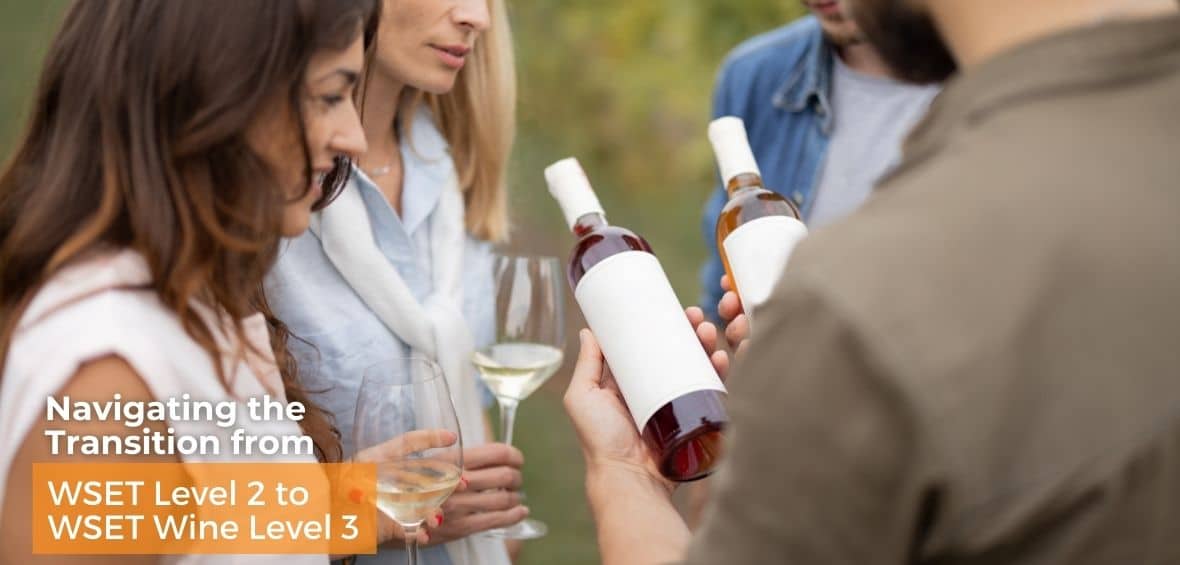In one level, you’ll learn the “what” of the wine world. In another, you’ll begin to understand the “why” and “how.” Find out which Level is right for you.
Congratulations, you’ve decided to enter the fantastic and rewarding realm of wine education! You’re well versed in the fundamentals and good to bypass WSET Level 1 – but how do you know if WSET Level 2 is right for you or if you are ready to leap right into WSET Level 3? As a WSET Educator, prospective students often ask me this very question.
WSET Level 2 is perfect for wine lovers and industry professionals who have a good foundation and are looking to expand their knowledge. Do you want to be able to look at a classic wine’s label and understand its style without tasting a drop? Do you want to know how a bottle of Cabernet Sauvignon from Napa Valley differs from a Coonawarra Cabernet? And, are you ready to put in about 30 hours of reading, studying, and tasting—culminating in a 50-question multiple-choice exam? If you’re nodding your head yes to all of this, then Level 2 is for you.
How Level 3 differs from Level 2:
If WSET Level 2 teaches you about the “what” of the wine world, WSET Level 3 teaches the “why” and “how.” It builds on the facts and tasting skills learned in Level 2 and is perfect for students who work in wine, as well as enthusiasts.
You will have a multiple-choice test, and your final evaluation will include four short-written answer questions and a blind tasting of two wines. It’s recommended that you spend around 80+ hours of study time, so that come exam day, you are ready to explain how natural factors (like climate and topography) and human factors (like winemaking choices) impact a wine’s style.
For example, in Level 2, you learn that Riesling vineyards in the Rheingau of Germany are planted on the north bank of the Rhine River with a southerly aspect. In Level 3, you learn what it means and how it impacts the styles of wines of the region. For example, the forest-capped Taunus Hills protect the vineyards of the Rheingau from cold northerly winds while acting as a heat-reflecting surface from rays bouncing off the Rhine, helping grapes to ripen fully, making ripe flavored wines with medium to full body.
In Level 2, you learn that Malolactic Conversion is a winemaking process carried out by bacteria, which softens the acid in wine and adds buttery flavors to whites. In WSET Level 3, you take it to the next level and put the puzzle pieces together. You will be prepared to explain why the producer of an outstanding quality Chardonnay from the Russian River Valley AVA may choose to use Malolactic Conversion to impact style. The answer (in case you’re wondering) is that the cool, foggy conditions in the Russian River Valley can produce high-acid Chardonnay. Malolactic Conversion will soften and reduce acidity to bring balance to the wine. This will also give the wine a round, creamy mouthfeel and can enhance its quality by adding complexity, creating nuanced buttery flavors.
What about the blind tasting? It might sound like the most intimidating part of Level 3, but it’s enjoyable and quite revealing. Tasting and evaluating wine is a learned skill—something you’ll practice over and over and hone during your 10-week class. With some dedicated practice, you’ll be ready for exam day—even if formal wine tasting is brand new for you.
So, what does all this mean for your enrollment choice? First, consider your current depth of knowledge. Can you answer some Level 2 questions with ease? E.g.,
- What is the primary grape of Priorat DOCa?
- True or False: Oloroso Sherry is aged under a thick layer of yeast called flor.
- Which Pinot Grigio would you expect to be more complex and full-bodied, one from Friuli-Venezia Giulia or the Veneto?
Next, look to your goals. How deep of a dive do you want to take? And finally, look to your time. Are you prepared to put in the work necessary for WSET Level 3?
So, what do you think is right for you? Is it time for Level 2 or Level 3?
ANSWERS:
- (Garnacha)
- (False)
- (FVG)













